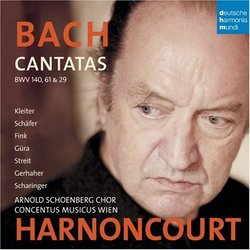| All Artists: Bach, Nikolaus Harnoncourt Title: Cantatas Bwv 29 61 & 140 Members Wishing: 0 Total Copies: 0 Label: Masterworks Original Release Date: 2/2/2010 Release Date: 2/2/2010 Genre: Classical Styles: Historical Periods, Classical (c.1770-1830) Number of Discs: 1 SwapaCD Credits: 1 UPC: 886976026622 |
Search - Bach, Nikolaus Harnoncourt :: Cantatas Bwv 29 61 & 140
CD Details |
CD ReviewsMaster class in Bach interpretation Stephen Midgley | Tarbrax, West Calder, UK | 01/31/2010 (5 out of 5 stars) "Here are three of Bach's finest cantatas in beautiful recordings from an acknowledged master of Bach performance. The disc begins with one of the best-known, "Wachet auf, ruft uns die Stimme" (BWV 140), and immediately we are struck by the urgency of the dotted orchestral motifs, especially in the lower parts, which continue with profound effect throughout the opening choral movement. The Concentus Musicus Wien play beautifully and the Arnold Schoenberg Choir are superb as always. For the remaining movements the soloists all do an excellent job, with the bass Anton Scharinger especially fine. Equally, the instrumental playing is lovely, with outstanding contributions from the violin and oboe soloists. The famous accompanied chorale movement, "Zion hört die Wächter singen", which generally used to be sung by the tenor section of the chorus, is here taken by the soloist Kurt Streit. In the concluding chorale, once again, the lower orchestral parts are given prominence, and to great effect. Altogether this is probably the most thoughtful, heartfelt and profound interpretation of this extraordinary work that I have heard. Like the other cantatas on the disc it was recorded live, and the sound throughout is superb.
The other two works receive interpretations of similar quality. BWV 61, "Nun komm, der Heiden Heiland", opens with incisive, dramatic phrasing from the instruments and superb entries from the choir. The soprano Christine Schäfer delivers a lovely performance of the beautiful aria "Öffne dich, mein ganzes Herze". Following this, BWV 29, "Wir danken Dir, Gott", is yet another favourite. Here, however, the brilliant opening sinfonia is unusually subdued, with the normally incisive punctuating motifs from the trumpets sounding rather polite. But this does have the advantage of giving the sparkling organ solo part greater prominence, and in fact Harnoncourt allows the movement to build up beautifully in the last few bars, thus leading very effectively into the powerful fugal chorus (music later re-used in the Gloria and Agnus Dei of the B minor Mass) which is here taken somewhat faster than in most other performances. Again the instrumental work and soloists are all excellent, with an especially fine aria from the tenor Werner Güra. Prospective buyers need to be aware that there are two versions of this recording available, one being a single disc as described above, and the other in a Limited Edition set of two CDs, with the second disc consisting of Harnoncourt's earlier performances of the same three works taken from the complete Teldec cantata series which he and Gustav Leonhardt recorded in the 1970s and 80s. It goes almost without saying that Harnoncourt's two sets of performances offer a truly fascinating contrast between old and new. The boy trebles of the two choirs in the originals, from Tölz and Vienna, still sound lovely, and the treble soloists who sing the soprano arias perform remarkably well in these very difficult roles. In the older version of no. 140 the orchestral playing - again by the Concentus Musicus - is excellent, their historic instruments and pointed phrasing still sounding wonderful. In the original no. 61 the opening chorus is if anything still more dramatic, and in my opinion the earlier version of this cantata has a slight edge over the new one apart from the soprano aria. In no. 29 the opening sinfonia sounds brilliant, again with a superb crescendo leading us into the first chorus. Once again the boy treble and the other soloists do a fine job, and altogether these performances still stand up extremely well to this day. So the limited edition 2-disc set is well worth choosing unless you already have the original recordings - or perhaps even if you do - especially since it costs very little more than the single CD. The booklet includes a fascinating interview with the conductor about his views and his development in Bach cantata performance; and even the cover sets the tone well with a photo portrait of a deeply thoughtful Harnoncourt. Overall, comparing old and new interpretations, there is a tendency to slightly faster tempi in the new versions, but in most cases you would hardly know it unless you switch tracks and make direct comparisons. Moreover, it seems to me, there are at times an extra vigour and incisiveness, and yet subtlety also, about the new versions. Either way, these recordings from Harnoncourt are absolutely outstanding for the feeling, sensitivity and sheer expressive power that he brings to the music of Bach, not by way of obvious rubato or any form of exaggeration but rather by infinitely subtle means. Somehow, Harnoncourt has a way of getting to the very heart of Bach that few others can equal, a special way with phrasing, a particular insight that brings the music straight into our hearts - and making it sound as if it is the language of today, as if it had just been written for us last week. This new cantata recording offers us a wonderful demonstration of these qualities. For me, it is one of the finest things Harnoncourt has ever done - and that, as many music-lovers will know, is saying a lot. " |

